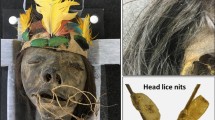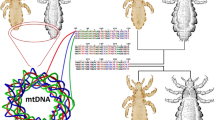Abstract
An investigation was conducted for the first time to determine the prevalence and genetic diversity of human lice, for the first time in Nigeria, using conventional PCR and sequencing methods. Three mitochondrial genes, cytochrome oxidase subunit 1 (cox1), cytochrome b (cytb), and 12S rRNA of Nigerian human lice, were amplified, sequenced, and analyzed. Overall, high prevalence (72.5%; 103/142) of lice infestation was recorded among the examined volunteers. Head lice infestation was more common 63 (61.2%) than body lice infestation 34 (33.0%). Co-infestation with both head and body lice was recorded in six humans (5.8%). The Nigerian human lice specimens were placed mostly into clade A with few in clade E, including body lice for the first time. Six, three, and eight haplotypes of Nigerian human lice were obtained for the cytb, cox1, and 12S rRNA genes, respectively. Additionally, one (E51), three (A31, A32, and E5), and six (A20, A21, A23, A24, A30, and E1) novel haplotypes were recorded for cox1, cytb, and 12S rRNA, respectively, from the Nigerian specimens which were corroborated by the ML phylogenetic trees and MJ network analyses. Genetic diversity indices indicate minimal variation in the parameters analyzed among the clades of the three genes. However, a statistically significant Snn test, negative Tajima’s D test for clade A (cox1 and 12S rRNA genes), and negative Fu and Li’s D test in clade A for cox1 gene indicate a geographical structure and the signature of population expansion of the Nigerian human lice. The findings from this study provide additional data on the human lice structure in Africa.








Similar content being viewed by others
Data availability
Nucleotide sequences generated in this study have been deposited in GenBank and is publically available. Other data can be made available on request to the authors.
References
Amanzougaghene N, Mumcuoglu KY, Fenollar F, Alfi S, Yesilyurt G, Raoult D et al (2016a) High ancient genetic diversity of human lice, Pediculus humanus, from Israel reveals new insights into the origin of clade b lice. PloS One 11:1–14. https://doi.org/10.1371/journal.pone.0164659
Amanzougaghene N, Akiana J, Mongo Ndombe G, Davoust B, Nsana NS, Parra HJ et al (2016b) Head lice of pygmies reveal the presence of relapsing fever Borreliae in the Republic of Congo. PLoS NTDs 10:1–18. https://doi.org/10.1371/journal.pntd.0005142
Amanzougaghene N, Fenollar F, Sangaré AK, Sissoko MS, Doumbo OK, Raoult D (2017) Detection of bacterial pathogens including potential new species in human head lice from Mali. PloS One 12:e0184621
Amanzougaghene N, Fenollar F, Davoust B, Djossou F, Ashfaq M, Bitam I, Raoult R, Mediannikov O (2019) Mitochondrial diversity and phylogeographic analysis of Pediculus humanus reveals a new Amazonian Clade “F”. Infect Genet Evol 70:1–8. https://doi.org/10.1016/j.meegid.2019.02.006
Amanzougaghene N, Fenollar F, Raoult D, Mediannikov O (2020a) Where are we with human lice? A review of the current state of knowledge. Front Cell Infect Microbiol 9. https://doi.org/10.3389/fcimb.2019.00474
Amanzougaghene N, Mediannikov O, Ly TDA, Gautret P, Davoust B, Fenollar F et al (2020b) Molecular investigation and genetic diversity of Pediculus and Pthirus lice in France. Parasite Vect 13(1):177. https://doi.org/10.1186/s13071-020-04036-y
Angelakis E, Rolain JM, Raoult D, Brouqui P (2011) Bartonella quintana in head louse nits. FEMS Immunol & Med Microbiol 62:244–246
Araújo A, Ferreira LF, Guidon N, Maues Da Serra Freire N, Reinhard KJ, Dittmar K (2000) Ten thousand years of head lice infection. Parasitol Today 16:269. https://doi.org/10.1016/S0169-4758(00)01694-X
Aris-Brosou S, Excoffier L (1996) The impact of population expansion and mutation rate heterogeneity on DNA sequence polymorphism. Mol Biol Evol 13:494–504. https://doi.org/10.1093/oxfordjournals.molbev.a025610
Ascunce MS, Fane J, Kassu G, Toloza AC, Picollo MI, González-Oliver A et al (2013) Mitochondrial diversity in human head louse populations across the Americas. American J Phys Anthropol 152:118–129. https://doi.org/10.1002/ajpa.22336
Ashfaq M, Prosser S, Nasir S, Masood M, Ratnasingham S, Hebert PDN (2015) High diversity and rapid diversification in the head louse, Pediculus humanus (Pediculidae: Phthiraptera). Sci Rep 5:14188. https://doi.org/10.1038/srep14188
Bandelt HJ, Forster P, Röhl A (1999) Median-joining networks for inferring intraspecific phylogenies. Mol Biol Evol 16:37–48. https://doi.org/10.1093/oxfordjournals.molbev.a026036
Bonilla DL, Durden LA, Eremeeva ME, Dasch GA (2013) The biology and taxonomy of head and body lice—implications for louse-borne disease prevention. PLoS Pathog 9(11):e1003724. https://doi.org/10.1371/journal.ppat.1003724
Boumbanda Koyo CS, Amanzougaghene N, Davoust B, Tshilolo L, Lekana-Douki JB, Raoult D, Mediannikov O, Fenollar F (2019) Genetic diversity of human head lice and molecular detection of associated bacterial pathogens in Democratic Republic of Congo. Parasite Vect 12:290
Boumbanda-Koyo CS, Mediannikov O, Amanzougaghene N, Oyegue-Liabagui SL, Imboumi-Limoukou RK, Raoult D, Lekana-Douki JB, Fenollar F (2020) Molecular identification of head lice collected in Franceville (Gabon) and their associated bacteria. Parasite Vect 13:410
Boutellis A, Bitam I, Fekir K, Mana N, Raoult D (2015) Evidence that clade A and clade B head lice live in sympatry and recombine in Algeria. Med Vet Entomol 29:94–98
Boutellis A, Veracx A, Angelakis E, Diatta G, Mediannikov O, Raoult D (2012) Bartonella quintana in head lice from Senegal. Vector Borne Zoonotic Dis 12:564–567
Brouqui P (2011) Arthropod-borne diseases associated with political and social disorder. Annu Rev Entomol 56:357–374. https://doi.org/10.1146/annurev-ento-120709-144739
Burgess IF (1995) Human lice and their management. Adv Parasitol 36:271–342
Candy K, Amanzougaghene N, Izri A, Brun S, Durand R, Louni M, Raoult D, Fenollar F, Mediannikov O (2028) Molecular survey of head and body lice, Pediculus humanus, in France. Vector-Borne Zoon Dis 18:243–251
Darriba D, Taboada GL, Doallo R, Posada D (2012) jModelTest 2: more models, new heuristics and parallel computing. Nat Methods 9(8):772
Drali R, Shako JC, Davoust B, Diatta G, Raoult D (2015) A new clade of African body and head lice infected by Bartonella quintana and Yersinia pestis - Democratic Republic of the Congo. Am J Trop Med Hyg 93:990–993
Drali R, Boutellis A, Raoult D, Rolain JM, Brouqui P (2013) Distinguishing body lice from head lice by multiplex real-time PCR analysis of the Phum_PHUM540560 Gene. PloS One 8:1–6. https://doi.org/10.1371/journal.pone.0058088
Eichler W (1956) Three new forms of head-lice from New Guinea, Java and Southwest Africa. Dermatol Wochenschr 133:657–660
Eichler W (1982) Head lice problems. I. Taxonomic position of Pediculus capitis. Angew Parasitol 23:102–109
Ewing HE (1926) A revision of the American lice of the genus Pediculus, together with a consideration of the significance of their geographical and host distribution. Proceedings of the US National Museum 68(p):1–30
Hammoud A, Louni M, Baldé MC, Beavogui AH, Gautret P, Raoult D, Fenollar F, Misse D, Mediannikov O (2021) Molecular characterization and genetic diversity of haplogroup E human lice in Guinea, West Africa. Microorganisms. 9:257. https://doi.org/10.3390/microorganisms9020257
Izri A, Uzzan B, Maigret M, Gordon MS, Bouges-Michel C (2010) Clinical efficacy and safety in head lice infection by Pediculus humanis capitis De Geer (Anoplura: Pediculidae) of a capillary spray containing a silicon-oil complex. Parasite 17:329–335. https://doi.org/10.1051/parasite/2010174329
Kempf M, Abdissa A, Diatta G, Trape JF, Angelakis E, Mediannikov O et al (2012) Detection of Acinetobacter baumannii in human head and body lice from Ethiopia and identification of new genotypes. Int J Infect Dis 16:14–16
Librado P, Rozas J (2009) DnaSP v5: a software for comprehensive analysis of DNA polymorphism data. Bioinformatics. 25:1451–1452
Leo NP, Barker SC (2005) Unravelling the evolution of the head lice and body lice of humans. Parasitol Res 98:44–47
Light JE, Allen JM, Long LM, Carter TE, Barrow L, Raoult D et al (2008) Geographic distributions and origins of human head lice (Pediculus humanus capitis) based on mitochondrial data. J Parasitol 94:1275–1281. https://doi.org/10.1645/GE-1618.1
Louni M, Amanzougaghene N, Mana N, Fenollar F, Raoult D, Bitam I, Mediannikov O (2018) Detection of bacterial pathogens in clade E head lice collected from Niger’s refugees in Algeria. Parasites Vect 11:348
Mumcuoglu K (2008) Pediculus and Pthirus. In: Raoult D, Drancourt M (eds) Paleomicrobiology of Past human infections. Springer, pp 215–222. https://doi.org/10.1007/978-3-540-75855-6
Nuttall GHF (1920) On Fahrenholz’s purported new species subspecies and varieties of Pediculus. Parasitol. 12:136–153
R Development Core Team R (2019) A language and environment for statistical computing. R Foundation for Statistical Computing, Vienna, Austria, p 2009
Raoult D, Reed DL, Dittmar K, Kirchman JJ, Rolain JM, Guillen S, Light JE (2008) Molecular identification of lice from pre-Columbian mummies. J Infect Dis 197:535–543
Reed DL, Smith VS, Hammond SL, Rogers AR, Clayton DH (2004) Genetic analysis of lice supports direct contact between modern and archaic humans. PLoS Biol 2. https://doi.org/10.1371/journal.pbio.0020340
Sangaré AK, Boutellis A, Drali R, Socolovschi C, Barker SC, Diatta G et al (2014) Detection of Bartonella quintana in African body and head lice. Am J Trop Med Hyg 91:294–301
Sunantaraporn S, Sanprasert V, Pengsakul T, Phumee A, Boonserm R, Tawatsin A et al (2015) Molecular survey of the head louse Pediculus humanus capitis in Thailand and its potential role for transmitting Acinetobacter spp. Parasite Vect 8:127
Tamura K, Stecher G, Peterson D, Filipski A, Kumar S (2013) MEGA6: molecular evolutionary genetics analysis version 6.0. Mol Biol Evol 30:2725–2729. https://doi.org/10.1093/molbev/mst197
Tobe SS, Kitchener A, Linacre A (2009) Cytochrome b or cytochrome c oxidase subunit I for mammalian species identification an answer to the debate. Forensic Sci Int Genet Suppl Ser 2:306–307
Veracx A, Rivet R, McCoy KD, Brouqui P, Raoult D (2012) Evidence that head and body lice on homeless persons have the same genotype. PloS One:e45903
Xiong H, Campelo D, Pollack RJ, Raoult D, Shao R, Alem M et al (2014) Second-generation sequencing of entire mitochondrial coding-regions (~15.4kb) holds promise for study of the phylogeny and taxonomy of human body lice and head lice. Med Vet Entomol 28:40–50. https://doi.org/10.1111/mve.12076
Yong Z, Fournier PE, Rydkina E, Raoult D (2003) The geographical segregation of human lice preceded that of Pediculus humanus capitis and Pediculus humanus humanus. C R Biol 326:565–574
Acknowledgements
The authors are grateful to Gajibo, AU, Laminu B, and Modu M for their assistance during the human lice samples collection.
Author information
Authors and Affiliations
Contributions
All authors read and approved the final version of the manuscript. Conceptualization, Investigation, Methodology, Writing—original draft; Writing—review &; editing (Joshua Kamani). Investigation, Data curation, Formal analysis, writing— review &; editing (Irene Sacristán) Investigation, Methodology, Writing—review &; editing (Nachum-Biala Yaarit). Design fig.1, Data curation, Formal analysis, writing—review &; editing (Mike Shand). Conceptualization, Methodology, Supervision, writing—review &; editing (Harrus Shimon)
Corresponding author
Ethics declarations
Ethical approval
Lice sampling was made in line with the specifications of the Declaration of Helsinki of the World Medical Association for the non-invasive sample collection from humans. Prior to sample collection, the representatives of the volunteers and the local authorities were briefed about the purpose of the study.
Consent to participate
Verbal consent to participate in the study and for the results to be published was obtained from each of the volunteers before they were examined for the presence of lice on the head or on their clothing in the presence of their representatives.
Competing interests
The authors declare no competing interests.
Additional information
Handling Editor: Julia Walochnik
Publisher’s Note
Springer Nature remains neutral with regard to jurisdictional claims in published maps and institutional affiliations.
Rights and permissions
Springer Nature or its licensor (e.g. a society or other partner) holds exclusive rights to this article under a publishing agreement with the author(s) or other rightsholder(s); author self-archiving of the accepted manuscript version of this article is solely governed by the terms of such publishing agreement and applicable law.
About this article
Cite this article
Kamani, J., Irene, S., Nachum-Biala, Y. et al. Phylogenetic and network analysis of Pediculus humanus in Nigeria reveal the presences of clade E body lice and novel haplotypes. Parasitol Res 122, 3087–3100 (2023). https://doi.org/10.1007/s00436-023-07999-w
Received:
Accepted:
Published:
Issue Date:
DOI: https://doi.org/10.1007/s00436-023-07999-w




